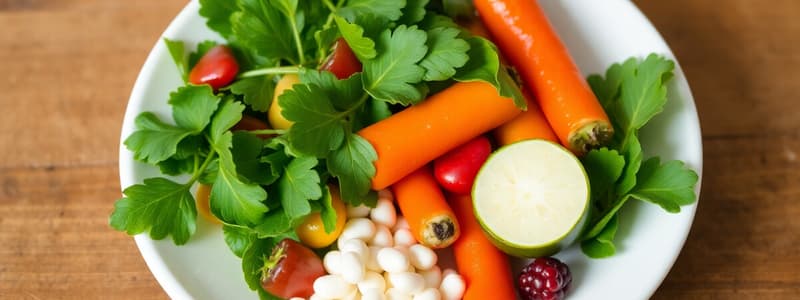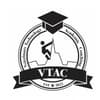Podcast
Questions and Answers
Which of the following best describes the primary function of lipids in the body?
Which of the following best describes the primary function of lipids in the body?
- Acting as enzymes to speed up metabolic processes.
- Serving as long-term energy storage, insulation, and cell membrane component. (correct)
- Providing the building blocks for muscle growth and repair.
- Serving as a source of quick energy for cellular activities.
Why is it important to consume water-soluble vitamins (like Vitamin C and B-complex) on a daily basis?
Why is it important to consume water-soluble vitamins (like Vitamin C and B-complex) on a daily basis?
- They are rapidly synthesized by the body and used in various metabolic processes.
- They are not stored in the body and any excess is quickly excreted. (correct)
- They are stored in large quantities in the liver and body fat, so daily consumption prevents accumulation.
- They are essential for bone formation and maintaining nerve function.
What is the primary role of minerals, such as calcium and iron, in the body?
What is the primary role of minerals, such as calcium and iron, in the body?
- To act as coenzymes in various metabolic processes.
- To provide a primary source of energy for daily activities.
- To aid in the digestion of complex carbohydrates.
- To play roles in bone formation, nerve function, and enzymatic reactions. (correct)
How does the mechanical digestion that occurs in the oral cavity (mouth) contribute to the overall digestive process?
How does the mechanical digestion that occurs in the oral cavity (mouth) contribute to the overall digestive process?
What is the role of peristalsis in the pharynx and esophagus during digestion?
What is the role of peristalsis in the pharynx and esophagus during digestion?
How do hydrochloric acid (HCl) and pepsin in the stomach contribute to digestion?
How do hydrochloric acid (HCl) and pepsin in the stomach contribute to digestion?
What is the significance of the duodenum in the small intestine?
What is the significance of the duodenum in the small intestine?
How do villi and microvilli enhance nutrient absorption in the small intestine?
How do villi and microvilli enhance nutrient absorption in the small intestine?
What is the primary function of the large intestine (colon)?
What is the primary function of the large intestine (colon)?
How does the structure of the stomach lining, with gastric pits and rugae, aid in its function?
How does the structure of the stomach lining, with gastric pits and rugae, aid in its function?
What is the key function of the crop in the bird's digestive system?
What is the key function of the crop in the bird's digestive system?
How does the gizzard aid in digestion within the bird digestive system?
How does the gizzard aid in digestion within the bird digestive system?
What is the role of the proventriculus in the avian digestive system?
What is the role of the proventriculus in the avian digestive system?
Which chamber of the ruminant stomach is primarily responsible for absorbing water and electrolytes?
Which chamber of the ruminant stomach is primarily responsible for absorbing water and electrolytes?
What is the main function of the abomasum in ruminant digestion?
What is the main function of the abomasum in ruminant digestion?
What is the primary role of the symbiotic bacteria and protozoa present in the rumen?
What is the primary role of the symbiotic bacteria and protozoa present in the rumen?
What transport mechanism is used for the absorption of proteins as amino acids in the small intestine?
What transport mechanism is used for the absorption of proteins as amino acids in the small intestine?
How are fats absorbed into the lymphatic system from the small intestine?
How are fats absorbed into the lymphatic system from the small intestine?
What is the role of the cecum in herbivorous mammals?
What is the role of the cecum in herbivorous mammals?
What is the result of reverse peristalsis?
What is the result of reverse peristalsis?
Flashcards
Carbohydrates
Carbohydrates
Primary energy source; found in grains, fruits, and veggies
Proteins
Proteins
Provide amino acids for growth, repair, and enzyme production; found in meat, dairy, legumes, and nuts
Lipids
Lipids
Long-term energy storage, insulation, and cell membrane component; found in oils, butter, and fatty meats
Vitamins
Vitamins
Signup and view all the flashcards
Minerals
Minerals
Signup and view all the flashcards
Water
Water
Signup and view all the flashcards
Oral Cavity Digestion
Oral Cavity Digestion
Signup and view all the flashcards
Peristalsis
Peristalsis
Signup and view all the flashcards
Stomach's Role
Stomach's Role
Signup and view all the flashcards
Duodenum Function
Duodenum Function
Signup and view all the flashcards
Large Intestine (colon)
Large Intestine (colon)
Signup and view all the flashcards
Rectum & Anus
Rectum & Anus
Signup and view all the flashcards
Mucosa Function
Mucosa Function
Signup and view all the flashcards
Submucosa Role
Submucosa Role
Signup and view all the flashcards
Muscularis Function
Muscularis Function
Signup and view all the flashcards
Serosa
Serosa
Signup and view all the flashcards
Bird Crop function
Bird Crop function
Signup and view all the flashcards
Proventriculus role
Proventriculus role
Signup and view all the flashcards
Gizzard Function
Gizzard Function
Signup and view all the flashcards
Reticulum
Reticulum
Signup and view all the flashcards
Study Notes
Nutrient Categories and Their Roles
- Carbohydrates are the body's primary energy source and are found in grains, fruits, and veggies.
- Proteins provide amino acids for growth, repair, and enzyme production; they are found in meat, dairy, legumes, and nuts.
- Lipids serve as long-term energy storage, insulation, and are an essential component of cell membranes and can be sourced from oils, butter, and fatty meats.
- Vitamins act as coenzymes vital for metabolic processes such as water-soluble ones (Vitamin C and B-complex), which are not stored and must be consumed daily.
- Fat-soluble Vitamins A, D, E, and K are stored in body fat and the liver.
- Minerals are inorganic elements that play roles in bone formation, nerve function, and enzymatic reactions, such as calcium, potassium, iron, and zinc.
- Water is essential for maintaining body temperature, transporting nutrients, and eliminating waste.
Human Digestive System
- The oral cavity uses chewing for mechanical digestion and salivary amylase for chemical digestion of carbohydrates.
- The pharynx and esophagus transport food to the stomach by swallowing.
- Peristalsis begins in the pharynx and esophagus.
- The stomach churns and mixes food into chyme through mechanical digestion.
- Pepsin begins protein digestion, and hydrochloric acid (HCl) denatures proteins and kills bacteria through chemical digestion.
- The duodenum is a major site for chemical digestion, where enzymes from the pancreas and bile from the liver/gallbladder enter.
- The jejunum and ileum are primarily responsible for nutrient absorption.
- The large intestine absorbs water and electrolytes, houses beneficial bacteria, and prepares waste for secretion.
- The Rectum & Anus provide temporary storage and elimination of feces/waste.
Histology of The GI Tract
- Mucosa: innermost layer for absorption and secretion; contains epithelial cells, goblet cells (mucus), and sometimes glands.
- Submucosa: supports and transports the mucosa through blood vessels, nerves, and lymphatics.
- Muscularis externa: responsible for motility and peristalsis; contains two layers of smooth muscle (circular & longitudinal).
- Serosa: the outermost protective layer with outer connective tissue.
- Stomach distinguishing features include gastric pits, rugae (folds), and pepsinogen secretion.
- Small intestine distinguishing features include villi and microvilli increase surface area.
- Large intestine distinguishing features include a lack of villi, but many goblet cells.
Bird Digestive System
- The crop is an enlarged part of the esophagus that stores and moistens food.
- Proventriculus is a glandular stomach that secretes digestive enzymes.
- The gizzard is a muscular organ that grinds food, often with ingested stones or grit.
- The Small Intestine is adapted for nutrient absorption.
- The cloaca is the standard exit for digestive and urinary tracts.
Peristalsis and Reverse Peristalsis
- Peristalsis: a wave-like series of involuntary muscle contractions in the smooth muscle layers pushes food (bolus/chyme) through the GI tract.
- Peristalsis is coordinated by the enteric nervous system.
- Peristalsis transports food regardless of body position.
- Reverse Peristalsis: moves food in the opposite direction, from the stomach or esophagus back towards the mouth.
- Reverse peristalsis is common in vomiting humans.
Chambered Stomach and Ruminants
- Ruminants like cows, sheep, and goats have a four-chambered stomach adapted for breaking down cellulose through microbial fermentation.
- Reticulum: A honeycomb structure that traps foreign materials and works with the rumen for regurgitating cud.
- Rumen: The largest chamber, acts as a fermentation vat filled with symbiotic bacteria and protozoa that break down cellulose.
- Omasum: Absorbs water, electrolytes, and some fatty acids, the folded inner surface increases the surface area.
- Abomasum: The "true stomach" secretes enzymes and HCl, similar to monogastric stomachs.
- These adaptations allow ruminants to extract nutrients from tough plant matter that other animals cannot effectively digest.
Increased Surface Area in The Digestive Tract
- Digestive efficacy relies on maximizing surface area for chemical digestion and nutrient absorption, achieved through smaller food particles and folded organ linings.
- Gastric Rugae: folds in the stomach lining that allow expansion and increase surface contact with food and gastric juices.
- Villi and Microvilli (intestinal brush border) are located in the small intestine.
- Villi are finger-like projections that contain blood vessels and lymphatic vessels (lacteals) for absorption.
- Microvilli are microscopic extensions on the epithelial cells of villi that drastically increase surface area and contain enzymes for final-stage digestion.
Duodenum: Chemical Digestion Hub
- The duodenum is named for the two ducts that open into it and is the first section of the small intestine.
- Bile Duct, from the liver/gallbladder, delivers bile, emulsifying fats.
- Pancreatic Duct, from the pancreas, delivers pancreatic enzymes such as amylase (breaks down starch), lipase (digests fats), and trypsin and chymotrypsin (digest proteins).
- Duodenal epithelial cells also secrete carboxypeptidase (cleaves amino acids), disaccharides (compete with carb digestion), and peptidases (complete protein digestion).
Final Absorption of Nutrients
- Absorption mainly occurs in the jejunum and ileum of the small intestine.
- Proteins are absorbed as amino acids in the small intestine via active transport into the blood
- Carbs are absorbed as monosaccharides (glucose) in the small intestine via facilitated diffusion or active transport.
- Fats are absorbed as fatty acids and monoglycerides in the small intestine (via lacteals)
Cecum and Appendix
- Cecum: A blind-ended pouch at the junction of the small and large intestine.
- The cecum in many herbivorous mammals houses microbes that help digest cellulose from plant fibers.
- Appendix: In humans, the appendix is a small, vestigial cecum.
- The human appendix may play a role in gut immunity and bacterial storage for microbiome recovery after illness.
Studying That Suits You
Use AI to generate personalized quizzes and flashcards to suit your learning preferences.





